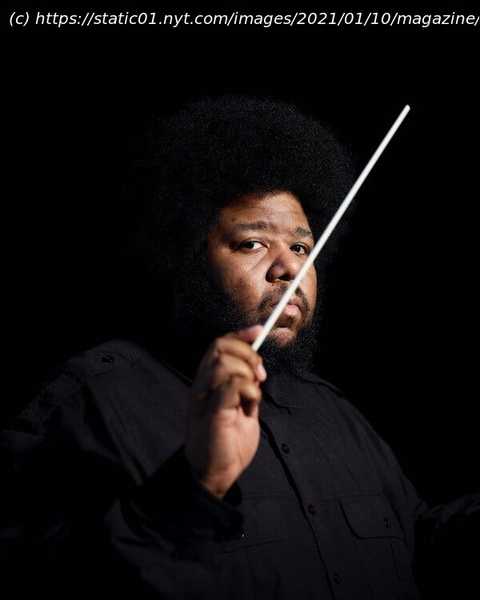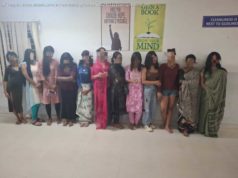The Newark native has long been lauded for his brilliant abstractions. Lately he’s writing about something more concrete — and producing his most powerful music yet.
To hear more audio stories from publishers like The New York Times, download Audm for iPhone or Android. On March 6, hardly a week before the pandemic lockdown began, close to a hundred people packed into the Jazz Gallery in New York City to hear a new sextet led by the drummer Tyshawn Sorey. When seats ran out — maximum occupancy is 75 — people stood against the wall or huddled together on the floor by the stage. Rio Sakairi, the club’s artistic director, worried that the city would shut down the concert as she passed around hand sanitizer. The anticipation in the room was tinged with dread. The death of the great jazz pianist McCoy Tyner was announced that day, and as we waited for the band to go on, his 1967 album, “The Real McCoy,” played on the loudspeaker. The two musicians had never met, but Sorey was so devastated by Tyner’s death that he nearly canceled the concert. By Sorey’s standards, the set was a short one: only two and a half hours. Sorey specializes in slow-moving “durational” music — on his first album with this sextet, “Unfiltered,” songs run as long as 55 minutes — and the music that evening flowed in a contemplative, somber vein, now and then building to moments of ferocious intensity. You could hear faint, beautifully modulated echoes of 1960s jazz: the dark modernism of Andrew Hill, the gnomic lyricism of Wayne Shorter, the gnarled intensity of John Coltrane, the raucous counterpoint of Charles Mingus. But what impressed me most was the confidence and authority of the orchestration. There were no breaks between songs, just an uninterrupted, seamless odyssey of music-making, anchored and steered by Sorey, in his signature Afro, sunglasses and a loose black button-down. Sorey is a big man, but he moved around his drum set with almost balletic grace, poise and concentration. As a coda, he led the band in a stirring rendition of Tyner’s ballad “Search for Peace.” When the set was over, Sorey said, he could hardly speak; he wanted to “live in that experience longer,” not hang out. So he slipped out of the club, only to be accosted by a group of older white admirers in the elevator. He smiled politely at their praise, but it was clear he preferred to be left alone. “I’m sorry,” he explained, “but I’m just feeling emotional about McCoy.” After we said goodbye on the street, he drove through the Lincoln Tunnel to his hotel in New Jersey and, still thinking of Tyner, “cried for hours.” Sorey who turned 40 over the summer, would be worth writing about for his drumming alone. The power, precision and inventiveness of his playing often draw comparisons with masters like Max Roach, Elvin Jones and Tony Williams. But Sorey refuses to play conventionally virtuosic drum solos — he prefers to play delicately and sparely, if at all — and he avoids being photographed with his sticks in the athletic poses that have defined the image of most jazz drummers. He is also a brilliant trombonist and pianist, and in the last few years he has become as arresting a figure in contemporary classical and experimental new music as he is in jazz: a favorite of The New Yorker’s classical-music critic Alex Ross; one of few Black composers ever to be invited to the new-music festival in Darmstadt, Germany; and a recipient of a 2017 MacArthur “genius” award. Sorey is one reason the worlds of jazz and classical music — of music that’s improvised and music that’s notated — seem less and less separate today. He’s far from the first jazz musician to compose for the classical concert hall: In the 1950s, there were “Third Stream” composers (Gunther Schuller, Jimmy Giuffre, John Lewis) who wrote for ensembles of classically trained musicians and jazz improvisers. But Sorey is neither “combining” genres nor “crossing over” from one into another. He does not so much bridge genre divides as cast them aside, as if they were a vestige of a prehistoric era, before artists as versatile as himself walked the earth. He can memorize and perform a complex score after glancing at it for 30 seconds, but he has no interest in reproducing sheet music note for note — including his own compositions, on which he expects musicians to improvise. “Playing with Tyshawn is like being onstage with the ocean,” the flutist Claire Chase told me. “You’re there with the ocean, and it’s serene and also dangerous and terrifying.” I remember feeling somewhat at sea myself the first time I heard him perform, in 2014 in a trio with the pianist Cory Smythe and the bassist Chris Tordini. The stage was so dark that I felt as if I’d wandered into a séance. For the next two hours, they performed a hauntingly ruminative suite of semi-improvised chamber music, upending the conventions of the “jazz piano trio,” in which a pianist leads a rhythm section. At times Sorey seemed to do little more than brush his cymbals, creating whispering sounds. At others he sat still while Smythe and Tordini interpreted his score, letting the music drift in near silence until it was shattered by the crash of his drums, so clear and so bright that the room itself seemed to light up. The music’s beauty lay in the fragile truce it achieved between calm and turbulence, between creating a mood of contemplative stillness and channeling all the forces that menace it. Sorey sometimes says his work is about “nothing” other than itself, but also describes it as “the means through which I ‘talk’ about social issues and other matters.” Both are true at once: His music is formally abstract but also permeated by his experience, especially his experience of Blackness. This does not always express itself in obvious or even audible ways; until recently, it has tended to emerge obliquely, down in what Ralph Ellison called the “lower frequencies.” Lately, however, Sorey has become more explicit about the moral and political passions beneath the rarefied surface of his aesthetics, writing vocal music set to poetry about Black lives. Silence and abstraction may remain his pillars, but he has given them a more explicit context and grounded them in more accessible forms. A result is some of the most expressive and powerful music he has written so far. When I first suggested a profile to Sorey last January, he was preparing for the Paris premiere of his oratorio about Josephine Baker, “Perle Noire,” which was written for the soprano Julia Bullock and set to texts by the poet Claudia Rankine. By the time we began talking in late March, all such events had been canceled. And as the pandemic unfolded its strange monotony and appalling casualties, the mix of stasis and upheaval in Sorey’s music struck me as almost eerily prefigurative of this era in American history. Performing artists were facing the literal cancellation of their culture; Sorey told me in April that he was afraid that he “might be looking at the end of my career as a performer.” A number of prominent jazz musicians would die of Covid-19: Ellis Marsalis, Henry Grimes, Lee Konitz, Wallace Roney. As an overweight Black man with asthma, Sorey was acutely aware of being at risk himself. He and his wife would eventually decide to home-school their young daughter, Naima, to help protect him from the virus. He was lucky to have plenty of high-profile commissions, but there was no telling when or how this new work would reach the public. “I’m writing music for the desk drawer,” he told me. We spoke on Zoom almost every week for the rest of the year. He was invariably in his office, dressed in black, with the lights off, boxes of CDs on the shelves behind him. Our conversations sometimes lasted for hours. Interviewing Sorey is a bit like listening to his music: a plunge into the longue durée, an introspective anatomy of what he has called the “cycles of my being.” The latest cycle, from the pandemic to this year’s killings of Black people by the police, has felt especially unsettling to him. At first he calmed his nerves by watching comedy (the absurdist “The Eric Andre Show” is a favorite) and posting about racism on social media, updating his thousands of followers on his state of mind. “I’m just doing what I need to do to survive,” he told me. But as the pandemic wore on, the convulsions of the late Trump era would propel him to embark on his most ambitious work yet: a vast book of songs about his own survival, and the survival of other Black Americans in the land they call, for better or worse, home. Sorey was born in 1980 in Newark. His parents, who mostly did odd jobs, split up when he was 3, and he and his mother were evicted from their apartment soon after. They moved into a housing project, but as the crack epidemic spread, life at home grew increasingly precarious, and Sorey preferred to stay with his paternal grandmother, Evelyn Smith, a day-care teacher who died in 2014. At 12, he moved into her apartment in Clinton Hill, among Newark’s most violent neighborhoods. Both parents remained in his life, but it was a “dark time,” he says, and he prefers not to talk about it. By 7, Sorey had been making sounds on radiators and pots and pans and playing hymns from memory on a beat-up piano in the basement of the Catholic church he attended with his grandmother. He wanted to play drums, but there were no drum sets at his elementary school, so he took trombone lessons instead. Later, his maternal grandfather, Herman Edward Sorey, gave him his first set. He also remembers his paternal uncle Kevin Smith, who looked out for him during his father’s frequent absences, taking him on jazz-buying expeditions at a record store in Elizabeth, the next town over. Like many Black children, Sorey was consigned for much of his youth to special education, possibly because of the slight lisp he still has. He was also bullied by other children, ridiculed as the overweight kid who walked around with a boombox listening to “white folks’ music.” (“It didn’t matter that it was Miles Davis,” Sorey recalls. “They didn’t know I was also very into hip-hop.”) His other comfort zone, besides music, was “Columbo,” the detective show; in Peter Falk’s character, he found a fellow oddball who cunningly took advantage of being underestimated. “I loved the pacing of each investigation,” he says. “Two hours is a long time for a kid to watch something like that. But a ‘Columbo’ episode is akin to a strangely modified sonata form — kind of like Beethoven’s mastery of it.” At Newark Arts High School, he studied trombone but also listened to all the great drummers — especially Max Roach, Elvin Jones and Tony Williams — and fell under the spell of Coltrane’s late expressionistic period. When he was 17, one of his teachers introduced him to someone who’d been among Coltrane’s fiercest champions: the Black Arts poet and critic Amiri Baraka, formerly known as LeRoi Jones. A native son of Newark, Baraka lived not far from Evelyn Smith’s house and ran a music-and-poetry salon called Kimako’s Blues People out of his basement. It was at Baraka’s salon that Sorey met generations of radical artists and visiting jazz ambassadors, including Max Roach himself, receiving an education in “the Black agenda” — lessons reinforced by his uncle Kevin, who taught him the history of Newark’s 1967 uprising and played him speeches by Malcolm X.






